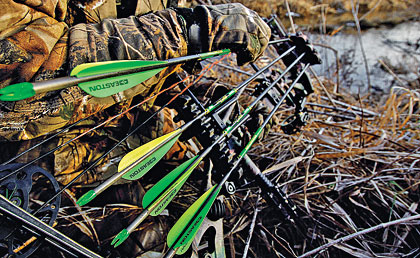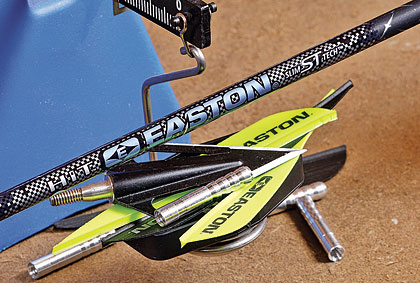November 08, 2010
By Bill Winke
I like small-diameter arrows for two important reasons. First, they penetrate better. Second, they don't drift as much in a crosswind.
By Bill Winke
 When selecting your arrows, consider the obvious features such as weight, straightness and stiffness. But don't forget to also consider diameter -- there are advantages to small-diameter shafts. |
I like small-diameter arrows for two important reasons. First, they penetrate better. Second, they don't drift as much in a crosswind. In this column, I'll dig deeper into why small-diameter arrows make sense and then take a look at the shafts available on the market.
Penetrating Power
This is going to seem slightly off-topic, but I'll bring the discussion back around. I get more questions from people about which broadhead is best than any other subject. That is a very hard question to answer, because certain features are important for one type of hit while others are important if you hit the animal somewhere else.
Advertisement
On a heavy tissue hit, I want a small, two-blade head for maximum penetration. If I hit them in soft tissue, I want a large cutting diameter for maximum damage. If you tell me where you are going to hit them, I'll tell you which broadhead to choose. See the problem? Personally, I end up choosing heads that penetrate well instead of those that cut giant wound channels. I do this just in case I hit the shoulder.
Advertisement
It is the same with arrows. To be on the safe side, I gear up for heavy tissue hits. I want arrows that promote penetration. Small-diameter arrows penetrate better than larger diameter arrows. I have known this since carbon arrows first came out and I witnessed, and even conducted, some conclusive penetration tests.
I've been party to two penetration tests that clearly showed smaller diameter arrows penetrate better than arrows with a larger diameter. Both were head-to-head tests using shooting machines, chronographs and grain scales. The same broadheads were shot on all arrows to keep everything fair, and all the bows were tuned to ensure no penetration was lost due to a poorly tuned rig. So, it is safe to say the results are reliable.
I witnessed the first test in 1993 in Chatfield, Minn., at the AFC plant. AFC later sold to Game Tracker. Game Tracker no longer makes the shafts, so the test data doesn't apply to any arrows currently on the market. Nevertheless, they represent a class of small-diameter shafts that are still offered by other manufacturers, and the data is revealing. The carbon shaft in this test (which weighed 493 grains) penetrated more than 40 percent deeper into both ethafoam and silica sand than the aluminum 2312 (which weighed 494 grains). That is an eye-popping advantage.
The second test was conducted in the late '90s. Using a shooting machine and chronograph to ensure consistency, carbon arrows were tested against aluminum shafts. The carbon shafts were internal component models, including the Beman ICS Hunter 340 at 319 grains (without the head) and Carbon Express 400 with 3 grains per inch weight tubes at 389 grains (without the head). The aluminum shaft was again the 2312, this time at 367 grains (without the head).
The data revealed that both carbon arrows penetrated 15-25 percent deeper, depending on the arrow and backstop media.
Diameter appears to be the main reason carbon shafts do so well in these tests. As the diameter goes down, so does the surface area, reducing friction as the shaft slams into the target. The outside diameters of the two shafts tested in 1993 were .233-inch for carbon and .360-inch for the 2312. Today's modern, small-diameter, internal component carbon shafts such as the Easton Axis and Trophy Ridge Crush have outside diameters of roughly .234-.245 inches.
 If you are looking for maximum penetration, it is hard to beat a mid-weight, small-diameter arrow, such as the Easton Axis, and a two-blade broadhead. |
The Axis and Crush are the latest wave of small-diameter carbon shafts, and they are the most impressive penetrating arrows I've ever seen. The Trophy Ridge shafts are very similar to the pultruded carbon shafts that were popular in the early '90s. This style went out of favor in the early 2000s as internal-component carbon shafts took over, but Trophy Ridge brought them back because advances in production technology have permitted straighter shafts.
The Easton Axis is smaller than other internal component carbon shafts because it uses an unconventional insert that presses completely inside the shaft. Easton calls it the HIT (Hidden Insert Technology) System. The inner diameter of arrow itself serves as the contact surface to center the broadhead ferrule. The Axis is also heavier than most carbon shafts on the market, making it a perfect choice for serious penetration.
Arrow weight is an important element of penetration, and once again you must strike a compromise with accuracy. Maximum accuracy at unknown ranges requires the flat trajectory of a light arrow. However, the more the arrow weighs, the more energy it will soak up from the bow and the harder it will hit. The best place to be in this trade-off is somewhere between 6-7 grains of finished arrow weight per pound of your bow's maximum draw force; for example, 420 grains for a 70-pound bow. A little heavier is also fine. Today's small-diameter carbon arrows fall right into that range.
Crosswind Accuracy
The amount of force exerted on the side of an arrow by a crosswind is proportional to the surface area of the arrow and its fletchings. The wind can't push a small-diameter arrow as hard as a wider arrow. The surface area for a 30-inch, small-diameter carbon arrow is roughly 6.8 square inches. For a standard carbon shaft it is roughly 8.7 square inches. For the 2312 aluminum, it is 10.8 square inches.
Based on these numbers, the amount of side force acting on the small-diameter shaft is 22 percent less than the standard carbon and 37 percent less than the aluminum. Since the shafts all weigh roughly the same, and the time in flight is roughly equal (because speed is much the same), the amount of drift ends up roughly proportional to the force. In other words, the small-diameter shaft will drift roughly 37 percent less than the aluminum in the same wind and 22 percent less than the standard diameter carbon arrow.
If you are looking for the ultimate performer in the wind, you need to look at these small-diameter shafts and couple them with the latest generation of short, stiff vanes.
Making the Switch
Despite all the test data, I stuck with large-diameter aluminum arrows for years longer than I wanted. I could tune them easily, whereas I struggled with the small-diameter carbon arrows, because of fletching contact with the rest. My opportunity to switch came with the advent of the drop-away rest. Suddenly, there was no longer a reason to shoot aluminum. With a drop-away rest, you can tune even the smallest diameter shafts easily.
It definitely makes sense to give the small-diameter carbon arrows a hard look this year. They excel in penetration, and crosswinds affect them less than other shafts. I can't find a downside to small-diameter arrows, as long as you are using a full-capture or drop-away arrow rest.
